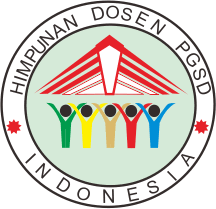Implementasi model two stay two stray untuk meningkatkan pemahaman konsep kegiatan ekonomi di sekolah dasar
Abstract
The research objective is improving the student’s understanding by using the Two Stay Two Stray (TSTS) model. This research is class action research that consists of 2 cycles. The subject is 35 students of 4 th grade of Pulisen State Elementary School Boyolali. Data collection techniques are conducted through observation, interviews, documentation, and tests. Data analysis techniques used are data reduction, data display, and conclusions. To determine the result of student learning outcomes, this research used source triangulation, and techniques. This research shows that students be able to comprehend the concept of economic activity increases. The first cycle result is classical pass percentage reach 75,76%. It increases in the second cycle become 91,18%. Based on observations and data, the conclusion of the Two Stay Two Stray (TSTS) model in this research could improve the understanding of the concept of economic activity. The implication of the TSTS model is that two people live in a group and two other people visit another group.
Keywords
Full Text:
PDFReferences
Taneo, Melkisedek. (2016). Pengaruh Metode Pembelajaran Field Trip vs Inkuiri dan Motivasi Berprestasi Terhadap Pemahaman Konsep Sejarah Lokal. Disertasi. Universitas Negeri Malang.
Solihatin, Etin & Raharjo. (2009). Cooperative Learning Analisis Model. Pembelajaran IPS. Jakarta: Bumi Aksara. Syah, Muhibbin Psikologi Belajar.
Wardana, L.W., Ratna S., Gledys H. (2018). The Implementation of the Two Stay Two Stray (Tsts) Learning Model and Co-Op Co-Op for the Improvement of Students’ Learning Outcome in the Crafts and Entrepreneurship Subject. KnE Social Sciences 3(3):140. DOI. 10.18502/kss.v3i3.1880.
D. Kurniawan. (2014). Pembelajaran Tematik Terpadu: Teori, Praktik, dan Penilaian. Bandung: Alfabeta.
Sardijiyo. (2012). Pendidikan IPS di SD (Tangerang Selatan: Universitas Terbuka).
Depdiknas. (2006). Permendiknas No.22 Tahun 2006 Tentang Standar Isi (Jakarta, Indonesia)
A. Fauzi. (2004). Ekonomi Sumber Daya Alam dan Lingkungan: Teori dan Aplikasi (Jakarta: Gramedia)
A. Ashari. (2017). Peningkatan Pemahaman Konsep Kegiatan Ekonomi Melalui Penerapan Model Advance Organizer Pada Siswa Kelas IV SD Negeri Karanganyar. Universitas Sebelas Maret.
Shoimin. (2014). 68 Model Pembelajaran INOVATIF dalam Kurikulum 2013. Yogyakarta: Ar-Ruzz Media.
D. Sulisworo & S. Fadiyah. (2014). The Effect of Cooperative Learning, Motivation and Information Technology Literacy to Achievement. Int. J. Learn. Dev (4).
M. Huda. (2015). Model-Model Pengajaran dan Pembelajaran: Isu-isu Metodis dan Paradegmis. Yogyakarta: Pustaka Belajar.
Sulisworo, D., & Suryani, F. (2014). The Effect of Cooperative Learning, Motivation and Information Technology Literacy to Achievement. International Journal of Learning & Development, (Online), 4(2).
Saputa, A. (2016). Use Of Two Stay Two Stray Strategy in Teaching Reading. English Education Journal (EEJ),(Online), 7(2).
Sugiyono. (2015). Metode Penelitian Pendidikan: Pendekatan Kuantitatif, Kualitatif, dan R&D. Bandung: Alfabeta.
Shoimin. (2013). 68 Model Pembelajaran INOVATIF dalam Kurikulum 2013. Yogyakarta: Ar-Ruzz Media
M. Arba'in. (2015). Peningkatan Pemahaman Konsep Sifat-sifat Cahaya Melalui Model Two Stay Two Stray Berbasis Eksperimen. Universitas Sebelas Maret.
Refbacks
- There are currently no refbacks.



